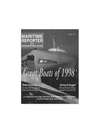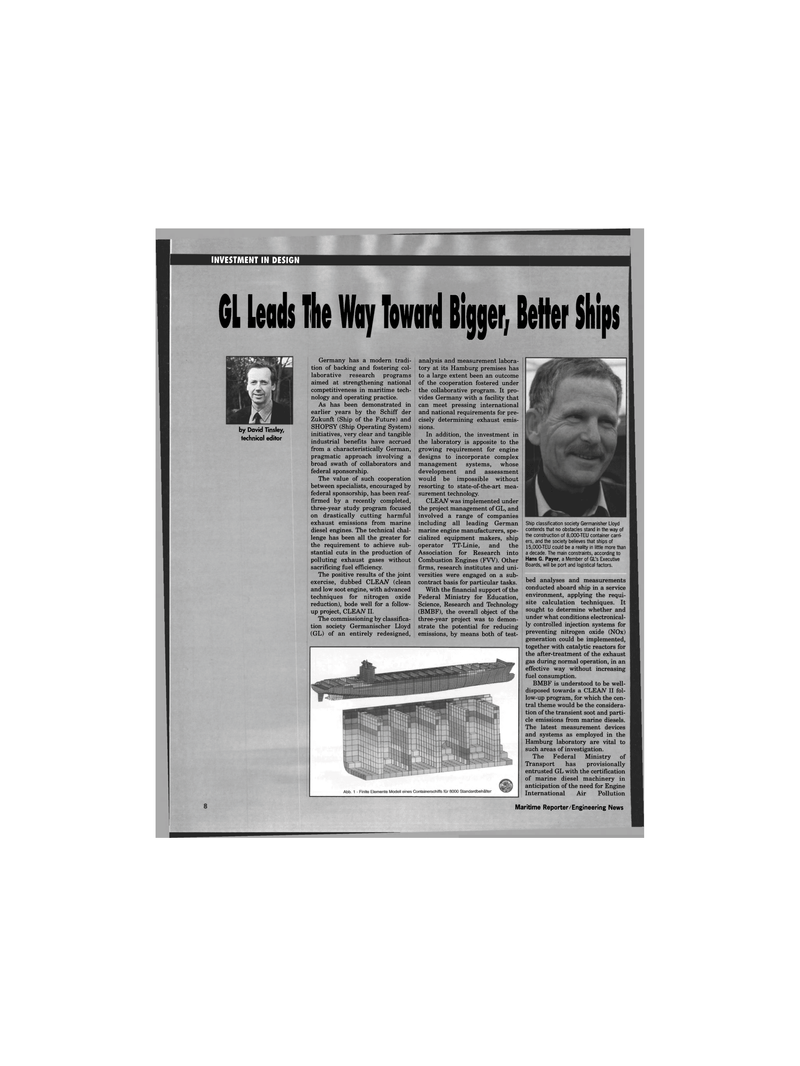
Page 8: of Maritime Reporter Magazine (January 1999)
Read this page in Pdf, Flash or Html5 edition of January 1999 Maritime Reporter Magazine
INVESTMENT IN DESIGN
GL Leads The Way Toward Bigger, Better Skips by David Tinsley, technical editor
Germany has a modern tradi- tion of backing and fostering col- laborative research programs aimed at strengthening national competitiveness in maritime tech- nology and operating practice.
As has been demonstrated in earlier years by the Schiff der
Zukunft (Ship of the Future) and
SHOPSY (Ship Operating System) initiatives, very clear and tangible industrial benefits have accrued from a characteristically German, pragmatic approach involving a broad swath of collaborators and federal sponsorship.
The value of such cooperation between specialists, encouraged by federal sponsorship, has been reaf- firmed by a recently completed, three-year study program focused on drastically cutting harmful exhaust emissions from marine diesel engines. The technical chal- lenge has been all the greater for the requirement to achieve sub- stantial cuts in the production of polluting exhaust gases without sacrificing fuel efficiency.
The positive results of the joint exercise, dubbed CLEAiV (clean and low soot engine, with advanced techniques for nitrogen oxide reduction), bode well for a follow- up project, CLEAN II.
The commissioning by classifica- tion society Germanischer Lloyd (GL) of an entirely redesigned, analysis and measurement labora- tory at its Hamburg premises has to a large extent been an outcome of the cooperation fostered under the collaborative program. It pro- vides Germany with a facility that can meet pressing international and national requirements for pre- cisely determining exhaust emis- sions.
In addition, the investment in the laboratory is apposite to the growing requirement for engine designs to incorporate complex management systems, whose development and assessment would be impossible without resorting to state-of-the-art mea- surement technology.
CLEAiV was implemented under the project management of GL, and involved a range of companies including all leading German marine engine manufacturers, spe- cialized equipment makers, ship operator TT-Linie, and the
Association for Research into
Combustion Engines (FW). Other firms, research institutes and uni- versities were engaged on a sub- contract basis for particular tasks.
With the financial support of the
Federal Ministry for Education,
Science, Research and Technology (BMBF), the overall object of the three-year project was to demon- strate the potential for reducing emissions, by means both of test-
Ship classification society Germanisher Lloyd contends that no obstacles stand in the way of the construction of 8,000-TEU container carri- ers, and the society believes that ships of 15,000-TEU could be a reality in little more than a decade. The main constraints, according to
Hans G. Payer, a Member of GL's Executive
Boards, will be port and logistical factors. bed analyses and measurements conducted aboard ship in a service environment, applying the requi- site calculation techniques. It sought to determine whether and under what conditions electronical- ly controlled injection systems for preventing nitrogen oxide (NOx) generation could be implemented, together with catalytic reactors for the after-treatment of the exhaust gas during normal operation, in an effective way without increasing fuel consumption.
BMBF is understood to be well- disposed towards a CLEAN II fol- low-up program, for which the cen- tral theme would be the considera- tion of the transient soot and parti- cle emissions from marine diesels.
The latest measurement devices and systems as employed in the
Hamburg laboratory are vital to such areas of investigation.
The Federal Ministry of
Transport has provisionally entrusted GL with the certification of marine diesel machinery in anticipation of the need for Engine
International Air Pollution 10 Maritime Reporter & Engineering News

 7
7

 9
9
